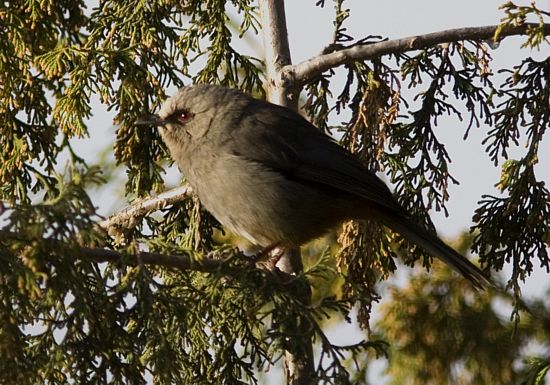Alternative names: Abyssinian Babbler; Juniper Babbler
- Sylvia galinieri
Parophasma galinieri
Identification
A dull grey babbler-like passerine (17-19 cm):
- Dirty grey plumage
- White forehead
- Black lores
- Rufous-chestnut vent
Sexes similar, juveniles are generally paler.
Distribution
Endemic to the highlands of Ethiopia.
Fairly common in parts of its range.1
Taxonomy
This is a monotypic species.[1]
Uncertain affinities. May be close to Bush Blackcap or the Mountain-Babblers. Now thought to belong to the Old World Warblers, not the Babblers.
Habitat
Dense thickets, giant heather, juniper woodland, highland bamboo, olive trees, well-wooded gardens. Often in steep-sided valleys or ravines. Found between 2440m and 3655m.1
Behaviour
Feeds on juniper berries and other fruit.
Usually seen in pairs or small groups of up to 8 birds. Keeps in vegetation. Fine singer.
Breeding season from January to July. The nest is a thin cup made of fine plant stems and placed on top of some small branches, about 5m above the ground. Lays 2 eggs.
Resident species.1
References
- Del Hoyo, J, A Elliott, and D Christie, eds. 2007. Handbook of the Birds of the World. Volume 12: Picathartes to Tits and Chickadees. Barcelona: Lynx Edicions. ISBN 978-8496553422
- Clements, J. F., T. S. Schulenberg, M. J. Iliff, S. M. Billerman, T. A. Fredericks, J. A. Gerbracht, D. Lepage, B. L. Sullivan, and C. L. Wood. 2021. The eBird/Clements checklist of Birds of the World: v2021. Downloaded from https://www.birds.cornell.edu/clementschecklist/download/
- Lepage D. (2022) [1]. Retrieved 17 September 2022
Recommended Citation
- BirdForum Opus contributors. (2025) Abyssinian Catbird. In: BirdForum, the forum for wild birds and birding. Retrieved 5 April 2025 from https://www.birdforum.net/opus/Abyssinian_Catbird
External Links
GSearch checked for 2020 platform.




